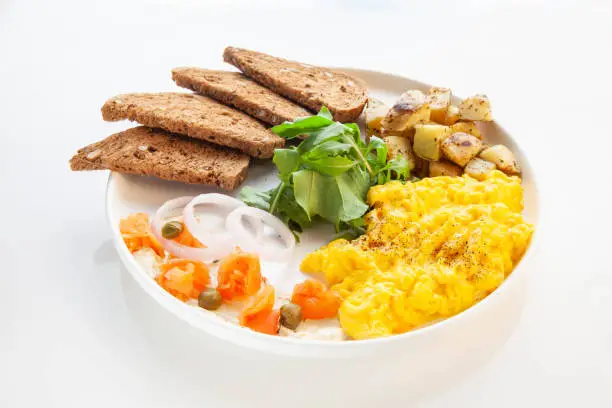A frittata is an Italian omelet that is partially cooked on the stovetop and then broiled in the oven. Why? Because the frittata is served open-faced you want it evenly cooked with both the topside and the underside uniformly browned as much as possible. If an omelet is served open-faced but is not even the least bit cooked in an oven, is it still a frittata? That’s like saying cakes and bread are always cooked in the oven; if they aren’t, then you have something else but not a cake or bread. Then, you’ll have half of the world screaming bloody hell because in Asia, cakes can be steamed and breads can be cooked in a frying pan. So, whatever.
The point is, I made an omelet, cooked frittata style, but because I love cooking omelets in my non-stick frying pan which cannot go into the oven, the frittata was cooked entirely on the stovetop. I cooked both sides though. How? By flipping the frittata halfway through the cooking time with the help of a plate. It’s a trick I’ve been using for a long time, I’m sure other recipes in the archive mention it, but just in case you haven’t seen it especially if you haven’t been a reader all that long, I’ll describe it again.
Heat the butter in a non-stick pan (you can use a regular pan but better heat the pan before adding the butter to prevent sticking). Pour the fish-potato mixture into the pan, spreading and pressing to fill the pan and to ensure even thickness. Cook over medium-low heat, partially covered to allow steam to escape, for 10 to 12 minutes or until the edges are browned.
Take a plate that is at least as large as the frying pan and place over the frittata. With one hand pressed on the bottom of the plate and the other on the panhandle, invert the pan, catching the frittata with the plate. Slide the frittata back into the pan and cook, partially covered, for another eight to 10 minutes over low heat. To serve, slide the frittata onto a plate or invert as before depending on which side you want to be visible.
In my case, the frittata is always more browned on the underside (the side that was first cooked in the photo above) because I make sure that the frittata is firm enough before attempting to invert it. Otherwise, it cracks in places. So, the cooking time for the topside is somewhat shorter (below). Of course, you can always choose to cook the topside for just as long but be careful that the vegetables don’t overcook and get mushy.
So, what goes well with frittata? It’s great by itself, you get carbs from the potatoes, protein from the fish and you have some greens in there too. But frittata also goes well with rice or bread. Bread? Oh, sure. Just because it is a fish frittata doesn’t mean it can’t go with bread. In the still-hot pan, place a split pan de sal or whatever bread you like. Spread mayo on the lower half (or a piece of sliced bread is your thing), place a slice of frittata on top, add a few slices of cheese then cover with the other half (or piece) of bread.

